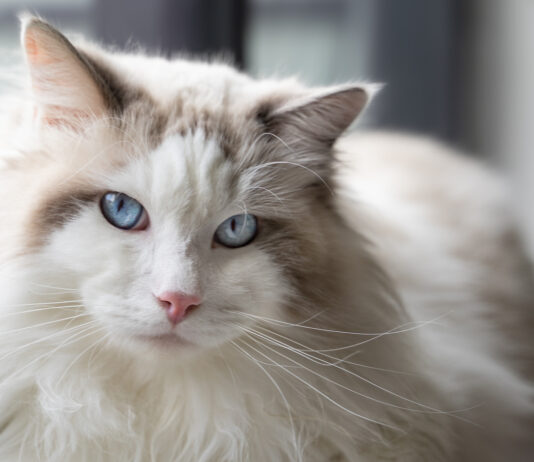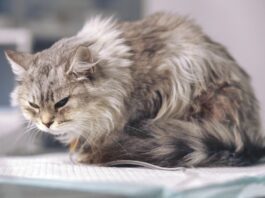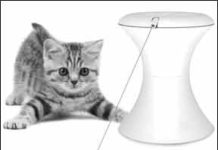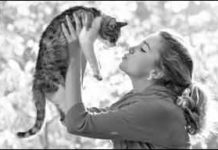Ask Elizabeth: July 2013
I completely understand your thoughts on this matter, as recent developments have caused many owners (and cats … believe it or not!) to reconsider their habits and the effects that their lifestyle may have on native populations. The recent study suggesting that domestic cats are contributing to the demise of billions of birds and small mammals points out the fact that the interaction of domestic species with native wildlife is an important issue, one that requires careful thought and action.
Why Do They … Chase Lasers Beams?
Cats love to chase lasers’ points of light, twirling, leaping, pouncing. They engage in the behavior with gleeful abandon for one simple reason: “The jumpy, erratic movement of the light beam can stimulate predatory-like play behavior,” says Pamela Perry, DVM, Ph.D., a lecturer in animal behavior at the Cornell University College of Veterinary Medicine.
Why Do They Chase Lasers Beams?
Cats love to chase lasers’ points of light, twirling, leaping, pouncing. They engage in the behavior with gleeful abandon for one simple reason: “The jumpy, erratic movement of the light beam can stimulate predatory-like play behavior,” says Pamela Perry, DVM, Ph.D., a lecturer in animal behavior at the Cornell University College of Veterinary Medicine.
Ask Elizabeth: May 2013
Thank you so much for recognizing how adorable it is when we cock our heads to one side. We’re only trying to look cute when we do this … it really serves no function. I’m kidding, although I’d have to think about this, which makes me want to tilt my head to the side, too! Seriously, though, this behavior is to be distinguished from the dramatic tilting of the head that may suggest an inner ear infection (the inner ear is important for the maintenance of balance) or that may be seen when cats have ear mites or an external ear infection. Cats with abnormalities of the brain, including tumors, may also tilt their heads to one side, and any cat who demonstrates persistent head tilt and/or shaking of the head should be evaluated by a veterinarian promptly.
Smart Tactics to Stop Destructive Chewing
Pipper loved to lick plastic and crawled eagerly into every plastic bag she could find. But the longhaired black cat’s fascination with plastic eventually progressed to a big problem — chewing the plastic and ingesting tiny pieces to the alarm of her owner, Pamela Perry, DVM, Ph.D., a lecturer in animal behavior at the Cornell University College of Veterinary Medicine. While some dogs chew sundry objects from shoes to sofa legs, cats tend to focus on houseplants, thread, string, yarn and electrical cords. Some, though, like Pipper, chew plastic, and Dr. Perry reached a turning point with the threat to her cat’s health. Ingested plastic could lead to an intestinal blockage. “I had to make sure that all plastic bags were put away,” she says. “They had to be well-hidden or she would find a way to get them.”
How Lost Animals Find Their Way Back Home
Heartwarming reports of lost dogs trekking miles back home regularly make the news. Now it’s a cat’s turn. Most recently: Holly, an indoor cat who bolted from her owners’ RV at Daytona Beach. Two months — and 190 miles later — an emaciated Holly arrived a mile from her West Palm Beach home. A woman took her to a veterinarian who found a microchip with the owners’ information.
Short Takes: April 2013
A survey of more than 50,000 U.S. households has uncovered a puzzling disconnect between cat owners’ beliefs and actions. Owners in 2011 said they increasingly consider their cats family members — 56 percent, up from 49.4 percent in 2006. Yet just 27.1 percent of owners say they took their cats to the veterinarian only when they were sick. Given that the feline population in the U.S. is approximately 74.1 million, about 20 million pet cats went without regular checkups and care in 2011.
New Options for Separation Anxiety
Collars and diffusers that dispense calming pheromones have become popular among owners eager to ease their catsf separation anxiety. Less generally known but promising new options are supplements and specialized diets. gThe area of veterinary nutraceuticals to treat anxiety is becoming quite active,h says Katherine A. Houpt, VMD, Ph.D., former president of the American College of Veterinary Behaviorists and James Law Professor emeritus of Animal Behavior at the Cornell University College of Veterinary Medicine. gDietary supplements with ingredients like green tea, as well as flower essences like Harmonease, are also now available.h
Ask Elizabeth: April 2013
First, I think it is great that your friend is taking advantage of the joy that a service dog can bring into people’s lives, and I want to give a shout out to my dedicated canine friends and the wonderful people who work so hard to make their mission possible. These dogs are awesome and are, for the most part, very carefully screened with respect to behavior, so I doubt there will be any problems with the dog having difficulty with the cats. It wouldn’t hurt, however, to speak with the foundation providing the dog to see if it has advice regarding the introduction.
Why Do They Cover/Uncover the Litter Box?
This occasional series explores the reasons for cats’ often intriguing behavior. If you would like to suggest a topic, please write CatWatch Editor, 800 Connecticut Ave., Norwalk, CT 06854, or email catwatcheditor@cornell.edu. One of the enduring mysteries of cats’ behavior is why they cover their feces after eliminating. One theory is that they’re trying to hide their presence from predators, as cats in the wild are believed to do, but no studies support that idea. Another suggests that the behavior is an indication of cats’ fastidiousness, but that doesn’t explain fastidious cats who leave urine or feces uncovered. The real answers are far more complicated.
When You Want to Adopt a Stray
Your next cat may show up when you least expect it. You glance out the window and see a skinny cat with a dirt-smudged coat looking back at you. He doesn’t rush to greet you like a lovable, lost Labrador Retriever. He sizes you up, determining if you’re friend or foe. You place bowls of food and water on the back porch to prevent him from starving or becoming dehydrated, but as the days pass and the cat moves closer to you and lets you pet him, you’re smitten. You’ve made the transition from performing an act of kindness to wanting to provide a safe, loving home.
Ask Elizabeth: February 2013
As you know, we cats are very sensitive creatures, but in your case, as with other cats with feline hypersensitivity syndrome (FHS), this sensitivity seems to be ratcheted up to varying degrees. FHS is a recognized syndrome in the feline world, although the definitive cause is not clear at this time. While it is not, in and of itself, believed to be serious with respect to its effect on overall health or longevity, a few important points regarding this unusual behavioral syndrome are worth making, especially for our human friends who are commonly puzzled by its manifestations. FHS, also variably referred to as rolling skin syndrome and atypical neurodermatitis, is characterized by dramatic twitching or rippling of the skin, most commonly on the back between the middle of the spine and the base of the tail or in the flank region, with intermittent jerking of the body and exaggerated tail movements.










